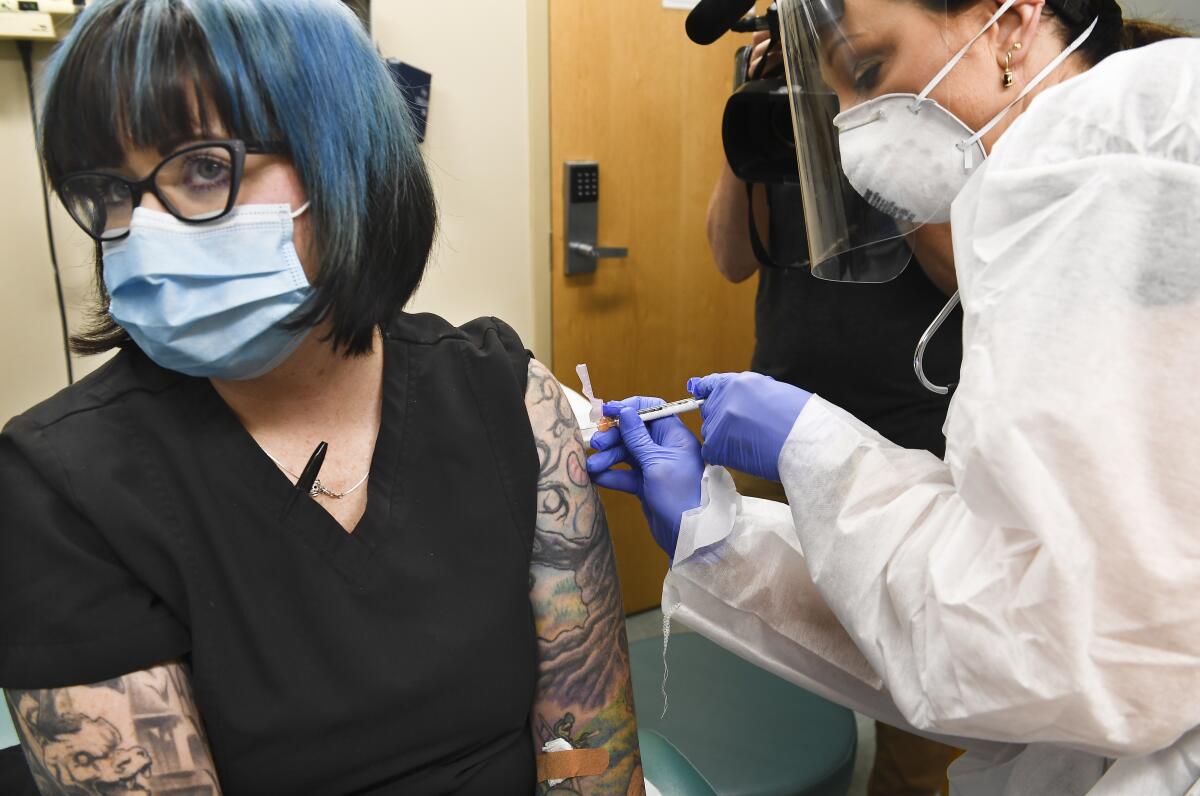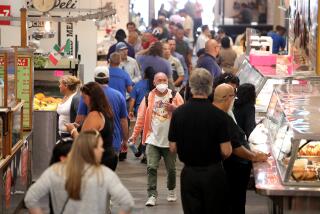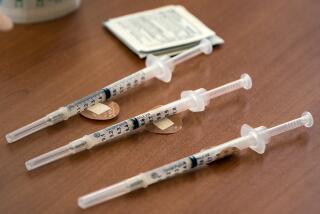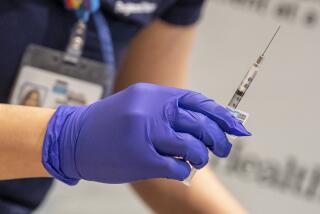Four takeaways from the race for a COVID-19 vaccine

There’s no silver bullet that will bring the COVID-19 pandemic to a rapid close, but an effective vaccine is the next-best thing. And now there are two candidates that have delivered encouraging reviews.
Preliminary results from tests of a vaccine being developed by Moderna Inc. and the National Institutes of Health suggest it may be up to 95% effective at preventing the disease. A similar vaccine created by Pfizer and BioNTech was also found to be 95% effective in a separate preliminary analysis.
Both Moderna and Pfizer say they will request emergency use authorization from the Food and Drug Administration within a matter of weeks, potentially clearing the way for tens of thousands of Americans to receive their first shots before year’s end. But considering that there are hundreds of millions of Americans in need of vaccination, there’s still a long way to go before the shots can return us to our pre-pandemic lives.
That said, these early signs of success make a few things clear. Here are four takeaways from the race for a COVID-19 vaccine.
1. A new method of making vaccines has arrived.
Both the Moderna and Pfizer vaccines were created using a new method that combines genetic engineering and immunotherapy. They’re called mRNA vaccines, and their aim is the same as vaccines that preceded them — to teach the immune system to recognize and attack a viral invader.
But they do so differently. To design and make them, their creators depart from the long-followed practice of selecting, isolating and cultivating specific proteins to be carried into the cells, where they can jump-start an immune response against a virus.
Instead of delivering the proteins themselves, mRNA vaccines deliver a genetic program so that the body’s cellular machinery can make the proteins on-site. Once produced, those proteins — called antigens — spur the immune system to generate an army of antibodies that will recognize and attack the virus.
Faster and easier than traditional vaccines to design, alter and manufacture, an mRNA vaccine primes the body to attack the actual coronavirus without being exposed to the real thing. Once proven and established, these mRNA vaccine “platforms” promise to come to the rescue far more quickly than predecessors, to be readily changed if a virus makes a sudden shift, and potentially treat a wide range of noninfectious diseases — such as cancer, spinal cord injuries and neurodegenerative conditions like Parkinson’s — as well.
Decades of government investment had fueled scientists’ hopes that this approach to vaccine design would work, despite plenty of scientific obstacles encountered along the way. Now we have evidence that vaccines made this way actually work in humans — and it’s happened not once, but twice.
Though preliminary, the new findings “reinforce optimism” for the new method, said Arthur Caplan, a bioethicist at New York University. That could soften a level of skepticism that had led close to half of Americans to express doubts about whether they would get a COVID-19 vaccine, he said.
If these results are sustained and supplemented by reassuring safety data, he added, “that level of efficacy will really start to corrode skepticism. You tell someone, ‘You have a 95% chance of not dying,’ and it gets your attention.”
2. The first vaccines may reduce the pandemic’s toll, but they may not slow the outbreak.
A vaccine is often deemed successful enough for broad use if a shot (or two) can prevent the immunized person from becoming ill or dying after exposure to a virus. If clinical trials are designed to look more deeply, and the vaccine works really well, it might be shown to achieve a more demanding definition of success: It could induce such a decisive response that those who get the shot can’t transmit the virus to others.
It’s hard to tell the difference when clinical trials are operating on compressed schedules with tens of thousands of participants. All volunteers would have to be tested for infection regularly, whether they feel sick or not, and researchers would have to pore over a ton of additional data to determine the vaccine’s impact on measures such as viral load.
That will be done in time, but we’re still far from knowing whether these vaccines will meet that higher bar.
Easing the duration or severity of illness will surely save lives. But that makes a vaccine more like a medicine and less like a powerful pandemic-buster.
Indeed, if mass vaccination reduces deaths but increases the number of people with low-level or asymptomatic infections instead of serious illnesses, it could create a situation in which the virus spreads more easily. The virus might still circulate widely, but vaccines will have made it more of a nuisance than a scourge.
Both the Pfizer and the Moderna vaccines were highly effective at reducing cases of symptomatic illness among those who were vaccinated. In the case of the Moderna trial, there are also signs that the vaccine was able to prevent severe disease: All 11 cases of COVID-19 that progressed to “severe” status occurred in the placebo group, and none in the group that received the vaccine.
But to understand whether either vaccine can help bring the pandemic to a faster close, we’ll need to know more about whether they prevent coronavirus infections.
“These early trials are not designed to tell us if transmission is prevented, unfortunately,” said Dr. William Schaffner, an infectious disease specialist at Vanderbilt University.
3. Vaccine hesitancy can be countered with retail distribution.
The initial vaccines are expected to be offered to healthcare workers, first responders, people at significantly higher risk of becoming severely ill if infected, and nursing home residents. Many people on the list will willingly roll up their sleeves when asked. But some won’t be eager to step forward for the shot.
Among those at highest risk of serious illness and death from infection are Black Americans, many of whom mistrust the medical establishment due to a long history of race-based discrimination and grievous ethical lapses. In September, the Pew Research Center reported that only 32% of Black adults said they would definitely or probably get a COVID-19 vaccine, compared with 52% of white adults, 56% of Hispanics and nearly three-quarters (72%) of Asian Americans.
As it happens, the vaccines likely to become available first will require distribution systems that put them before prospective vaccine recipients in two very different ways.
The Pfizer vaccine, 100 million doses of which have already been bought by the U.S. government, will have to be stored in specialized containers kept at minus-94 degrees Fahrenheit (or minus-70 degrees Celsius). As a result, it’s likely to be dispensed in mass vaccination drives and at urban medical centers that can support such technically demanding conditions.
Moderna’s vaccine needs to be kept on ice as well, but only at minus-4 degrees F (or minus-20 C). Those conditions are closer to a regular freezer than an Arctic winter. That means it can be offered in doctors’ offices, church basements, schools and local pharmacies. And that means it’s likely to be proffered by trusted members of the community — a pastor, teacher, neighbor, local pharmacist, or family doctor.
“That will facilitate acceptance if your trusted provider can say, ‘I got it. I think you should too,’” Schaffner said. “And it makes it possible for us to bring vaccine to the people rather than muster the people to get the vaccine.”
4. Herd immunity is a little closer than it was last week.
A vaccine’s efficacy matters when it comes to ending a pandemic. To reach herd immunity — the point at which an outbreak peters out — a vaccine must reduce the number of viral spreaders or the pool of people those spreaders can infect, or both.
The pandemic can be sustained only when an infectious person can walk into a place like a bar or a gym and find at least one new victim to infect. Eliminate the supply of potential new victims by vaccinating them all, and the virus has nowhere to go.
Eliminate the supply of spreaders, and you may slow the pandemic even faster.
Over time, rigorous monitoring studies will clarify the pros and cons of the various vaccines that will be fielded in the U.S., said Dr. Walter Orenstein, an Emory University vaccinologist.
Some will do best at suppressing transmission, and they can be used for essential workers, frequent travelers and people who can’t or won’t wear a mask. Others will be particularly good at protecting those at greatest risk of dying if they do get infected, and they can be used on residents of long-term care facilities, prison inmates and others who don’t circulate so widely.
“Herd immunity requires lots of vaccine,” and it’ll be awhile before we have that, Orenstein said. It’s critical that scientists and policymakers use the early days of scarcity to plot their next steps, gathering better data on what these new vaccines can do to end the pandemic.
In the meantime, reducing the pandemic’s toll of sickness and death is an objective well suited to the vaccines’ limited supply and scientists’ limited understanding of what they do most effectively, he said.
And that’s a start.







